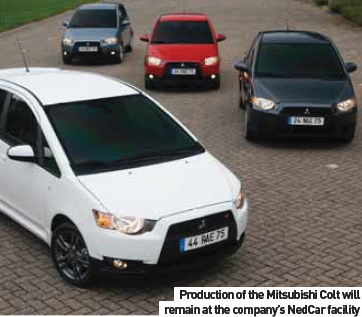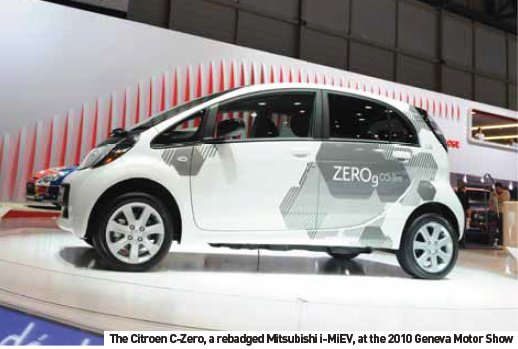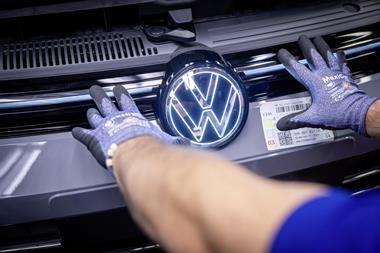
It is an observation of gross understatement to say that Nick Reilly, President of GM Europe and CEO of Opel/Vauxhall, has his work cut out for him. Having taken the lead role in the reorganization of Opel on an interim basis after the resignation of Carl-Peter Forster, Reilly, who was head of GM’s international operations (based in Shanghai), took formal control of GM Europe in December last year. Since then, he has overseen the sale of Saab Automobile to Spyker Cars, announced the intention to close GM’s under-performing Antwerp plant, applied for bridging loans to various European governments and outlined plans for the production of a series of new models.
 Now based at Opel’s Russelsheim facility, Reilly drove some of the 566km from the plant to the Geneva Motor Show in the new Ampera, the European version of the Chevrolet Volt. While this journey stands as real-world testimony to the strength of the technology underpinning the new electric vehicle, he revealed in an interview at the Geneva show that European production of the car has yet to be finalized.
Now based at Opel’s Russelsheim facility, Reilly drove some of the 566km from the plant to the Geneva Motor Show in the new Ampera, the European version of the Chevrolet Volt. While this journey stands as real-world testimony to the strength of the technology underpinning the new electric vehicle, he revealed in an interview at the Geneva show that European production of the car has yet to be finalized.
“It depends on when we think we want to produce it in Europe and that depends on the volumes. I’m quite optimistic that we’ll be wanting to produce it (here) in a couple of years, but we don’t have to make that decision yet.” If the Ampera is built in Europe, will it be built in Russelsheim? “We don’t know where the Ampera is going to be produced yet. It’s a size smaller than the Insignia, so it could go into various different plants. The natural plant for this vehicle is not Russelsheim.” If not Russelsheim, could the car be given to Ellesmere Port in the UK? “It’s one of the candidate plants we’re looking at,” says Reilly, who adds that the decision covering production location is likely to be made in 2011.
Reilly points out that the Ampera bridges the transportation gap left by other EVs. “Some people will not be going to a gas station for a month – but then they’ll want to go on a long trip. The Ampera can do both, save energy and offer extended range. The brand will gain kudos from that; that is our investment.”
While vehicle pricing is not usually a topic covered in AMS, it is noteworthy with regards to the Ampera, considering the extended development period – and cost - of the new Voltec drivetrain technology. Reilly: “We will not price the Ampera to cover the investment cost... but we’re not in this for charity. I expect that we’ll lose money for the first few years, working down the costs while the ball gets rolling, but I think we can make money on that car.” It will help the cause of GM Europe – and the company as a whole – if the Voltec drivetrain is shared over different model ranges, such as the Cadillac Converj, a concept vehicle slated to feature the new powertrain. “It’ll help if we do the Converj, though there’s still some questions about whether we’re going to continue with the model. It doesn’t matter, though, if it’s the Converj or not. The powertrain and technology will certainly be used in more cars than the Chevrolet Volt and Ampera; there’ll be a Buick version in the US. Also, it’s scaleable – so you can take (the powertrain) up to an Insignia size, or you can take it down to a Corsa size. So all those things will add volume and reduce costs.” Reilly says that he believes many customers will want to purchase the Ampera simply because of the car’s ‘green’ credentials. But he emphasizes that for real volumes, the car must also be an economically-attractive proposition. This, he continues, will come with government incentives for the purchase of EVs, and GM working on next-generation model versions in order to further reduce component costs. According to Reilly, GM has already reduced the cost of the battery pack in the Ampera by more than 50%, but as he says, “it’s still pretty expensive”.
GM’s Brownstown Township facility is reported to be currently preparing for the start of battery pack production for the Volt/Ampera later this year. Could the packs also be built in Europe, as a way to off-set production and shipping costs? “The battery cells are coming from LG Chem,” says Reilly. “We are taking the cells and we’ll manufacture the packs in the US to begin with, but as volumes grow I could see that being done in Europe as well.”
Future solutions
Even with the planned closure of its plant in Antwerp, Belgium, GM Europe will still be facing an over-capacity problem. Answering how he plans to address the issue, Reilly reveals that he is looking to a recovering European market for assistance. “The Antwerp closure leaves us with over-capacity today. But the market’s very depressed today. We don’t want to close a plant and open up another three years later. If we take Antwerp out and reduce capacity in other plants, if our projections are accurate, then by 2013, our capacity (utilized on a two-shift basis) would be at 112% and on a three-shift basis, just under 90%. That’s a pretty healthy position to be in. You can run plants on two or three shifts quite efficiently. If the markets take much longer to come back, we’ll run them on two shifts for longer; if it’s stronger, we’ll put them on three shifts more quickly. We do have some flexibility there, we think what we’re doing is about right.”
Another production concern for Reilly is that of GM Luton, located in the UK. Currently manufacturing the Opel/Vauxhall Vivaro, Renault Trafic and Nissan Primastar commercial vehicles, the contract production of the latter two models is shortly coming up for renewal. “We are discussing with Renault what may happen, there are a lot of different considerations on both sides that go into that decision. We would like to continue the relationship, it has been very positive, very successful in the marketplace.” As to whether the two companies will continue to jointly produce CVs, Reilly says that he expects to have an answer by mid-2010. “If it’s ‘yes’, that’s fine. If it’s ‘no’, then we need to look for a different product for the Luton plant.” In the event that Renault decides to look elsewhere for its CV production needs, does Opel/Vauxhall have the necessary resources to develop its own programme, taking into consideration the company’s current cash shortage? “We could build it. We have alternatives, in-house being one of those, and there are other alternatives out there. But our preference is to continue with what is a good relationship. “Financially, the CV market volumes can be big, but not like passenger cars. If you’re amortizing the engineering investment over two or three companies, it makes sense, which is why there are so many alliances in the CV sector.” Reilly is also interested in extending Opel/Vauxhall’s compact segment range, including the addition of a small SUV. This new model, positioned beneath the Antara and Captiva SUVs is likely to come out of South Korea, but Reilly says this is only because it makes sense to produce the model on a single line. The versions destined for Europe will feature development work carried out by Opel.
Does the development and production of the new small SUV in Korea mark a move to produce higher-volume, lower-margin models outside Europe? “Not necessarily for Opel,” says Reilly. “We are intending to bring in the small SUV from the east because the volumes are sufficient to justify the investment for production outside Europe. But generally speaking, Opel will invest in Europe.” Reilly is confident GM will remain a force in European automotive production. In addition to the stability of new government financing, he points to the recent improvement of production efficiencies.
“Walking around the press shop in Russelsheim in the mid-90s, it wasn’t state-of-the-art, and neither was the work organisation. An outside company that did press shop efficiency rankings throughout Europe placed Russelsheim third from bottom, out of 30 companies. I went round there the other day and they were very proud to show me that (the ranking) had galvanized them into doing things differently. “The whole work flow, the work layout is now very efficient, they know exactly the timings they’re taking to change dies, they know how many hits they’re getting per minute, per hour. By 2002, the press shop had climbed to the middle of the ranking. This year, they were third out of about 28. It’s just one example of how we’re now perceived by an outside agency. It wasn’t that we’d spent a bunch of money, it was still pretty much the same press shop - though we did have some new presses – but there is a new sense of motivation.”
Mitsubishi Motors Europe
 Although Mitsubishi Motors and PSA Peugeot Citroen have announced that there will be no capital alliance between the companies, the two groups have confirmed that they plan to extend the already close ties linking the carmakers. Nowhere is this co-operation more clearly visible than in European vehicle production. The NedCar facility, which produces the Mitsubishi Outlander SUV and Colt hatchback (three- and five-door versions), also manufactures the Peugeot 4007 and Citroen C-Crosser SUVs, both of which are based on the Outlander chassis. The two companies are set to start production at a new €470m plant in Kaluga, Russia, which in addition to producing the Mitsubishi Outlander XL, will also build the Peugeot 308 hatchback (4007 to be added at a later date), and the Citroen C4 and C-Crosser. Peugeot and Citroen will also market rebranded versions of Mitsubishi’s i-MiEV electric vehicle, respectively named iOn and C-Zero, with both cars due to be available across Europe by the end of 2010.
Although Mitsubishi Motors and PSA Peugeot Citroen have announced that there will be no capital alliance between the companies, the two groups have confirmed that they plan to extend the already close ties linking the carmakers. Nowhere is this co-operation more clearly visible than in European vehicle production. The NedCar facility, which produces the Mitsubishi Outlander SUV and Colt hatchback (three- and five-door versions), also manufactures the Peugeot 4007 and Citroen C-Crosser SUVs, both of which are based on the Outlander chassis. The two companies are set to start production at a new €470m plant in Kaluga, Russia, which in addition to producing the Mitsubishi Outlander XL, will also build the Peugeot 308 hatchback (4007 to be added at a later date), and the Citroen C4 and C-Crosser. Peugeot and Citroen will also market rebranded versions of Mitsubishi’s i-MiEV electric vehicle, respectively named iOn and C-Zero, with both cars due to be available across Europe by the end of 2010.
In spite of the close manufacturing ties between PSA and Mitsubishi, the Japanese company remains responsible for its overall market performance. Genichiro Nishina, President and CEO of Mitsubishi Motors Europe says that over the first nine months of 2009 they controlled production volumes in order to reduce inventory. “This year, our retail volumes will equal our production/import volumes,” he says, “and we’re predicting 130,000 unit sales across all European markets, excluding Ukraine and Russia. Of that number, NedCar produces approximately 65,000 units, so coincidentally, the plant produces about half of the units sold here.”
Nishina says the remaining volumes are imported from Japan and Thailand, the latter delivering L200 (locally known as Triton) pickups to the European market. With the prohibitive costs of shipping and import duties affecting half of all Mitsubishi vehicles sold in Europe, will production at the Kaluga facility be used to supplement European inventory? ‘There are some risks, but we thought it was necessary to assemble and produce there. Also, there is a huge difference in taxation levels for imported cars and Russian-made cars, approximately 50% of finished vehicle value. In the long-term, Europe would be a potential opportunity, but for now, Kaluga is focused on supplying the recovering Russian market.”
In addition, Nishina points out that while the build quality of cars produced by foreign OEMs in Russia is improving, European consumers could be prejudiced against Russian-built cars. “We have to do some research into the consumer behaviour of western Europeans, with regard to how they view Russian-made cars. Even Japanese or western European brands have to consider how Russianbuilt cars are perceived.”
NedCar future
Mitsubishi’s NedCar facility, located in Born, Netherlands, recently started production of a CKD version of the Outlander  SUV. Genichiro Nishina says that in this way, the company pays reduced import duties in comparison to those levied on finished vehicles. It does, though, result in an extended supply chain. “We are looking into localizing parts, tires, batteries, etc, but only when it is commercially sensible do we try and switch from imported to local part sourcing. Localization is not the objective. You have to consider that in Japan, our purchasers may have committed to a supplier for a certain volume. If we suddenly switch supplier, we could face a penalty. Apart from this, we locally source diesel engines for Outlander; our 2.0-litre diesel from Volkswagen and the 2.2-litre diesel from PSA.”
SUV. Genichiro Nishina says that in this way, the company pays reduced import duties in comparison to those levied on finished vehicles. It does, though, result in an extended supply chain. “We are looking into localizing parts, tires, batteries, etc, but only when it is commercially sensible do we try and switch from imported to local part sourcing. Localization is not the objective. You have to consider that in Japan, our purchasers may have committed to a supplier for a certain volume. If we suddenly switch supplier, we could face a penalty. Apart from this, we locally source diesel engines for Outlander; our 2.0-litre diesel from Volkswagen and the 2.2-litre diesel from PSA.”
Moving on to the Colt, Nishina concedes that it is difficult to make a profit building small cars in the high-wage areas of northern Europe. Despite this, he says there are underlying reasons to continue building the hatchback at NedCar. “In view of the current and future EU regulations covering fleet automotive emissions, we need smaller cars to reduce our total CO2 emissions figure. The A1 is Audi’s answer to this, BMW’s Mini is another. If we imported the Colt, the EU would impose a 10% tariff on each vehicle, then there’s the freight cost. So we decided to produce Colt here. Our goal now is to reduce material costs in order to build profit into the car.”
NedCar, though, is still falling far short of its 200,000upa capacity. With carmakers unwilling or unable to support under-performing facilities, what lies in store for the plant? “It is a very complicated issue. MMC must consider the issue from the context of a global production strategy and the future product portfolio. Our product portfolio several years from now will be more ‘global’. To the best of my knowledge, no decision has been made as to what role NedCar will play in that.”
Cross-brand co-operation
Though both the NedCar and Kaluga facilities produce Peugeot and Citroen models on the same lines as the equivalent Mitsubishi vehicles, with the potential for crossbrand cannibalization from customers opting for a PSA product, Nishina believes that there is more value to be had than lost from such co-operation.
 “From Mitsubishi’s point of view, (the joint-venture) is a success. We were able to share some investment and development costs. That said, Outlander is not a commercial vehicle, so exterior design must be differentiated from the other models. Not only the front face or grille, but also some part of the rear and also the interior.”
“From Mitsubishi’s point of view, (the joint-venture) is a success. We were able to share some investment and development costs. That said, Outlander is not a commercial vehicle, so exterior design must be differentiated from the other models. Not only the front face or grille, but also some part of the rear and also the interior.”
He goes on to point out that Mitsubishi led with development of the Outlander platform, which then underwent various treatments at the hands of PSA. “Mitsubishi took care of the basic components and equipment, we led vehicle development of the Outlander. Fine-tuning was done as a collaboration. Their engineers are skilled in refining models, they have more know-how, or capability, in making the car suitable for western European tastes.”
In addition to the cross-brand marketing of the i-MiEV, Nishina says Mitsubishi plans to launch a full range of hybrid or electric vehicle versions. “We have a vision, a realistic vision, that by 2020 some 20% of all Mitsubishi vehicles will either use hybrid or EV technology. We are sure that battery technology will advance to meet the needs of motorists, with smaller, lighter cells of higher capacities.
“So we will continue to produce smaller cars as EVs,” he says, “but in larger, heavier, less aerodynamic models, we will use hybrid drivetrains.”


































